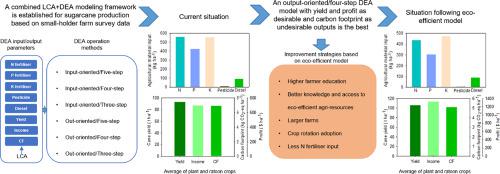Agricultural Systems ( IF 6.1 ) Pub Date : 2022-03-16 , DOI: 10.1016/j.agsy.2022.103392 Linsheng Yang 1 , Yifan Zhou 1 , Bo Meng 1 , Haojie Li 1 , Jian Zhan 1 , Huaye Xiong 1 , Huanyu Zhao 1 , Wenfeng Cong 2 , Xiaozhong Wang 1 , Wushuai Zhang 1 , Prakash Lakshmanan 1, 3, 4 , Yan Deng 1 , Xiaojun Shi 1 , Xinping Chen 1 , Fusuo Zhang 1, 2

|
CONTEXT
Sustainable crop production is critical to address the grand challenges of climate change and food security, and eco-efficiency is increasingly used to assess systems sustainability. Sugarcane is a major high biomass, high input sugar and bioenergy crop but with a relatively large carbon footprint. China is the third largest sugarcane producing country. However, its production eco-efficiency remains unclear. A reliable assessment of sugarcane crop production eco-efficiency is necessary to identify the most important targets and effective strategies to improve its economic and environmental outputs.
OBJECTIVES
This study aimed to i) establish an eco-efficiency assessment model framework suitable for sugarcane crop production system in general, ii) quantify the eco-efficiency of sugarcane production in China, and iii) propose strategies to improve sugarcane crop productivity, sustainability and economic profit, while reducing its environmental cost.
METHODS
Here, based on farmer survey data, we combined life cycle assessment (LCA) and data envelopment analysis (DEA) to determine eco-efficiency and sustainability of small-holder sugarcane farm production system in southern China. Six modelling approaches, including both input- and output-oriented, were used to assess sugarcane agriculture eco-efficiency.
RESULTS AND CONCLUSIONS
An output-oriented DEA model with yield and profit as desirable and carbon footprint as undesirable outputs proved to be superior to the other approaches for sugarcane production eco-efficiency assessment. The estimated average eco-efficiency of plant (first year) and ratoon (second year) crops were 0.803 and 0.869, respectively. Under this model, yield and profit were increased by 16.6% and 180% for plant crop, and 9.62% and 38.2% for ratoon crop, respectively, with a substantial reduction, up to 28%, in carbon footprint. The farm performance analysis indicated that the most eco-efficient farmers had large farms with crop rotation systems, lower fertiliser input, a relatively higher education, more acceptance of new farming practices and products, and better access to agriculture resources, compared with eco-inefficient farmers.
SIGNIFICANCE
Adopting the model outputs reported here will help eco-inefficient farmers to narrow their productivity gap, increase profit and make Chinese sugarcane farming more eco-efficient. This is the first report of eco-efficiency and sustainability assessment in sugarcane production using LCA + DEA framework, with potential for adopting it to other agricultural systems.











































 京公网安备 11010802027423号
京公网安备 11010802027423号